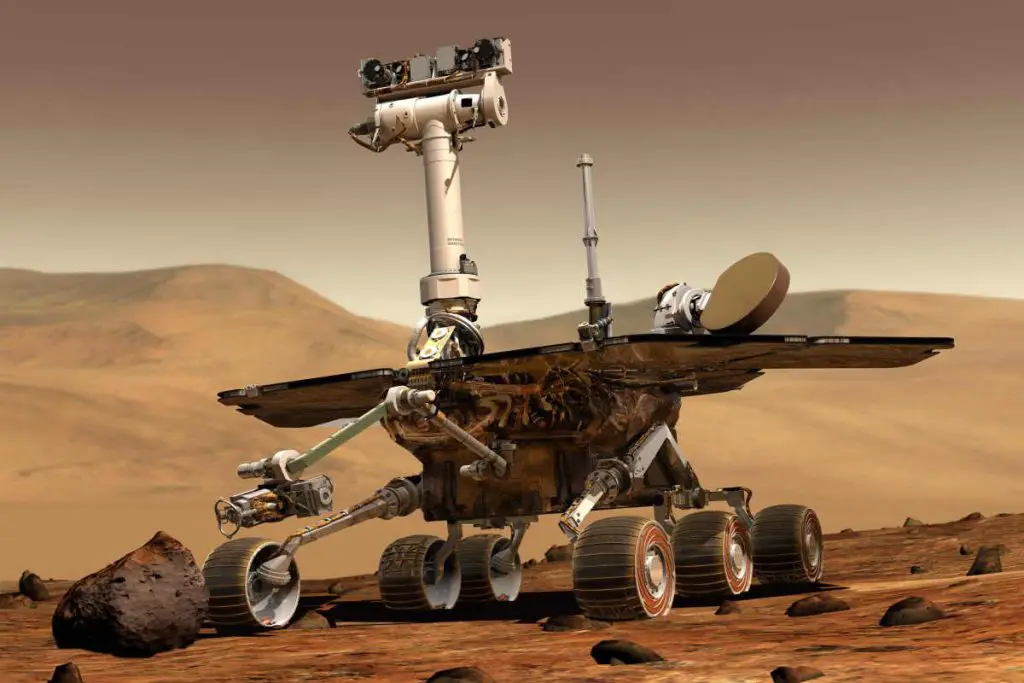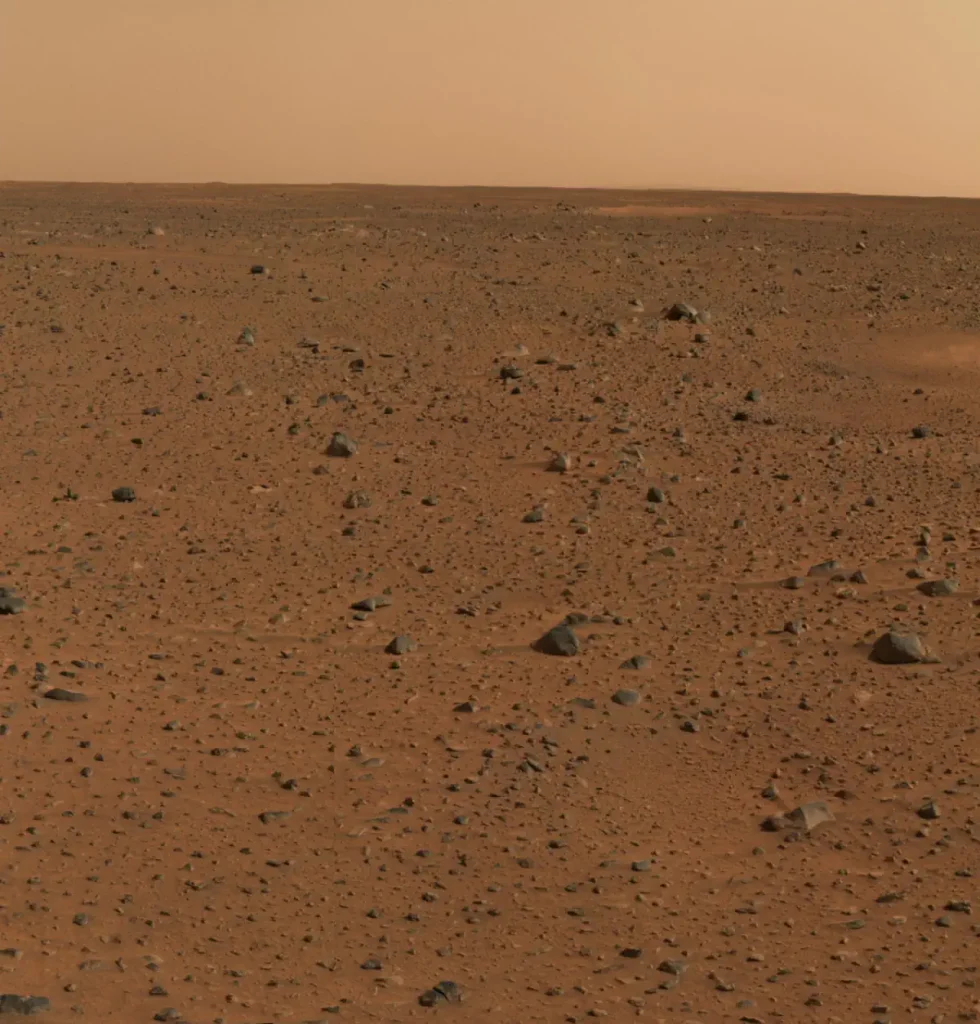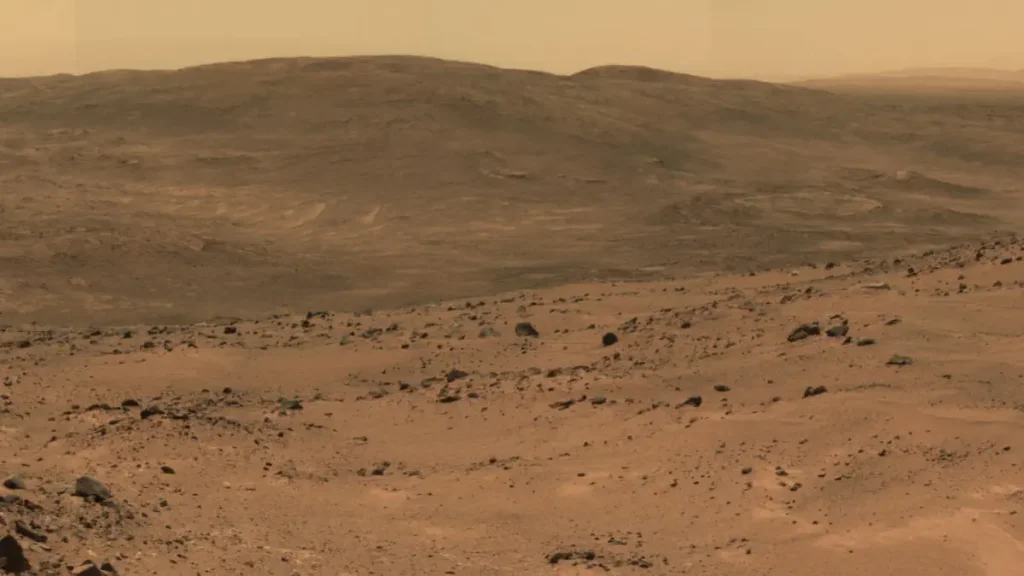On January 4, 2004, NASA’s Spirit Rover landed on Mars. It was a robotic Mars exploration vehicle, and with its twin Opportunity, studied the history of climate and water at sites on Mars where conditions may once have been favorable to life. Operational from January 4, 2004, to March 22, 2010, Spirit far outlasted her planned 90-day mission.
January 4 story of what happened this day in Science, Technology, Astronomy, and Space Exploration history.
Spirit Rover
Spirit (and its twin, Opportunity) are six-wheeled, solar-powered robotic rovers standing 1.5 meters (4.9 feet) high, 2.3 meters (7.5 feet) wide, and 1.6 meters (5.2 feet) long and weighing 180 kilograms (400 lb).
Six wheels on a rocker-bogie system enabled mobility over rough Martian terrain.
Each wheel had its own motor. The vehicle was steered at the front and rear and was designed to operate safely at tilts of up to 30 degrees.
The maximum speed of the Spirit rover was 5 centimeters per second (2.0 inches per second), or 0.18 kilometers per hour (0.11 mph). The average speed was about 1 centimeter per second (0.39 inches per second), though.
Both Spirit and Opportunity rovers had pieces of the fallen World Trade Center’s metal on them that were “turned into shields to protect cables on the drilling mechanisms”.

Mission objectives
NASA sought evidence of life on Mars, beginning with the question of whether the Martian environment was ever suitable for life. Life forms known to science require water, so the history of water on Mars is a critical piece of knowledge.
Although Spirit and Opportunity did not have the ability to detect life directly, they offered very important information on the habitability of the environment during the planet’s history.
The scientific objectives of the Mars Exploration Rover mission were to:
- Search for and characterize a variety of rocks and soils that hold clues to past water activity. In particular, the samples sought will include those that have minerals deposited by water-related processes such as precipitation, evaporation, sedimentary cementation, or hydrothermal activity.
- Determine the distribution and composition of minerals, rocks, and soils surrounding the landing sites.
- Determine what geologic processes have shaped the local terrain and influenced the chemistry. Such processes could include water or wind erosion, sedimentation, hydrothermal mechanisms, volcanism, and cratering.
- Perform calibration and validation of surface observations made by Mars Reconnaissance Orbiter instruments. This will help determine the accuracy and effectiveness of various instruments that survey Martian geology from orbit.
- Search for iron-containing minerals, and identify and quantify relative amounts of specific mineral types that contain water or were formed in water, such as iron-bearing carbonates.
- Characterize the mineralogy and textures of rocks and soils and determine the processes that created them.
- Search for geological clues to the environmental conditions that existed when liquid water was present.
- Assess whether those environments were conducive to life.
Scientific instruments carried by the Spirit rover
- Panoramic Camera (Pancam): examined the texture, color, mineralogy, and structure of the local terrain.
- Navigation Camera (Navcam): monochrome with a higher field of view but lower resolution. It was used by operators for navigation and driving.
- Miniature Thermal Emission Spectrometer (Mini-TES): identified promising rocks and soils for closer examination, and determined the processes that formed them.
- Hazcams, two B&W cameras with a 120-degree field of view, provided additional data about the rover’s surroundings.
The rover arm held the following instruments:
- Mössbauer spectrometer (MB) MIMOS II: used for close-up investigations of the mineralogy of iron-bearing rocks and soils.
- Alpha particle X-ray spectrometer (APXS): it was used for the close-up analysis of the abundance of elements that make up rocks and soils.
- Magnets: for collecting magnetic dust particles.
- Microscopic Imager (MI): obtained close-up, high-resolution images of rocks and soils.
- Rock Abrasion Tool (RAT): exposed fresh material for examination by instruments on board.
Launch and landing
NASA’s Spirit rover (also known as MER-A – Mars Exploration Rover – A or MER-2) was launched on June 10, 2003, on top of a Delta II rocket. Its twin, Opportunity was launched on July 8 of the same year.
It successfully landed on Mars on January 4, 2004, at 04:35 UTC. The landing site was the Gusev crater. Named after the Russian astronomer Matvey Gusev (1826-1866), Gusev is a giant impact crater (about 166 kilometers / 103 miles in diameter) and a possible former lake.
The entire rover package hit the Martian surface at 04:26 UT on January 4, 2004, at a velocity of about 46 feet per second (14 meters per second), bouncing 28 times before rolling to a stop about 820 to 980 feet (250 to 300 meters) from the point of the first impact. Landing coordinates were 14.5692 degrees south latitude and 175.4729 degrees east longitude. The landing was about 8 miles (13.4 kilometers) from the planned target.
Initially, Spirit transmitted data to Earth via Mars Global Surveyor. About an hour-and-a-half after landing and after the airbags deflated, the rover deployed its petal solar panels and began relaying information via the 2001 Mars Odyssey. Spirit immediately started transmitting spectacular images back to Earth (see the image below).

Major events during the Spirit mission
- The rover ran into a major problem on January 21, 2004, when NASA’s Deep Space Network lost contact. Due to a problem in Spirit’s flash memory subsystem, the rover entered a fault mode. Fortunately, controllers were able to reformat the flash memory and send up a software patch (to preclude memory overload). Normal operations resumed on February 5.
- The next day, on February 6, 2004, Spirit used its rock abrasion tool (RAT) to grind down the surface of a rock called Adirondack, a feat performed for the very first time on Mars. Investigating the exposed interior of the rock gave scientists important insights into the composition of Martian soil.
- The mission was originally planned to last 90 Martian days, until about April 4, 2004. Yet, mission planners were able to repeatedly formulate extended missions well beyond the rover’s original lifetime.
- Some of the subsequent highlights included a visit to Bonneville Crater, about 400 yards (370 meters) from its original landing point. The rover then went to the base of Columbia Hills where it spent an extended period of time.
- By 2005, Spirit began slowly making its way to the apex of Husband Hill, over terrain that was both rocky and sandy. It stopped at many locations to investigate, often using the RAT (Rock Abrasion Tool).
- In March 2005, a peculiar and strange event- the passing of dust devils that swept dust from the top of the solar panels- increased power coming to Spirit from the usual 60 percent to 93 percent, thus significantly extending the lifetime of the mission.
- On September 29, 2005, the rover finally reached the summit of Husband Hill, a small flat plain from which Spirit was able to take 360-degree panoramas in the true color of the Gusev Crater.

- Early in 2006, Spirit was directed to the north face of McCool Hill where it was assumed that Spirit would receive sufficient sunlight to maintain operations through the impending Martian winter. But, the trip to McCool Hill was eventually canceled, partly because a front wheel stopped working. This malfunction proved to be beneficial to scientists since the inactive wheel scraped off the upper layer of Martian soil as the rover moved, exposing bright silica-rich dust that indicated contact between soil and water.
- In early 2007, controllers uploaded new software to both Spirit and Opportunity. These new programs allowed the rovers to autonomously decide on a number of different actions, such as whether to transmit a particular image back to Earth or whether to extend the remote arm.
- Through much of the Earth summer of 2007, both Spirit and Opportunity faced massive dust storms that eroded their ability to operate effectively, mainly due to a lack of power generated from the solar panels.
- At the end of 2008, a winter storm further reduced the output of Spirit’s solar panel to about 89 watt-hours per Martian day. A normal amount would be about 700 watt-hours per day. At such low levels, the rover had to use its own batteries and if they ran dry, it would basically end the mission.
- Through 2009, a series of fortuitous events-such as the wind blowing the dust off the solar panels-the rover’s power slowly increased. By April 2009, the rover was back to about 372 watt-hours per day, sufficient for normal science activities to resume.
Spirit became stuck: end of the mission
Unfortunately, on May 1, 2009, while driving south beside the western edge of a low plateau called Home Plate, Spirit became stuck in soft soil, its wheels unable to generate traction against the ground. On November 28, another of Spirit’s six wheels, the right rear one, stopped working.
By late January 2010, after many attempts to move Spirit had failed, mission planners reformulated the Spirit mission as a stationary science platform.
One of its goals would now be to study the tiny wobbles in Mars’ rotation to determine the nature of the planet’s core – whether it is liquid or solid. To do that, however, the rover had to be tilted slightly to the north to expose its solar panels to the Sun, since the winter sun would be in the northern sky. In the end, the desired tilt was not achieved.
After March 22, 2010, mission controllers at NASA’s Jet Propulsion Laboratory (JPL) were not able to regain contact with Spirit.
Despite more than 1,300 commands sent to Spirit, NASA officially concluded its recovery efforts on May 25, 2011. The most probable cause of the loss of contact was the excessive cold that made its survival heaters ineffective.
By the time it stopped, Spirit had traveled about 4.8 miles (7.73 kilometers) across the Martian plains. It had operated for six years, two months, and 19 days, more than 25 times its original intended lifetime.
Major Accomplishments of the Spirit rover
- 2004: Discovered a surprising variety of bedrock in Columbia Hills, showing a complex geological history of the region. Some of the rocks showed evidence of alteration by water. Columbia hills are a range of low hills inside Gusev crater. The range is named to memorialize the Space Shuttle Columbia disaster.
- 2005: Captured several movies of dust devils in motion, providing the best look of the wind effects on the Martian surface as they were happening.
- 2006: Found evidence of an ancient explosion at a bright, low plateau called Home Plate. Spirit imaged coarse, bulbous grains overlaying finer material, which fits with the pattern of accumulation of material falling to the ground after a volcanic or impact explosion. These rocks, some of which had never been seen before on Mars, revealed the crater’s violent history.
- 2006: Churned up bright Martian soil at a place named Tyrone that contained much sulfur and a trace of water. This material could be a volcanic deposit formed around ancient gas vents or could have been left behind by water that dissolved these minerals underground and evaporated when they came to the surface.
- 2007: Unearthed a patch of nearly pure silica, the main ingredient of window glass, while dragging its right front wheel. The silica patch, dubbed “Gertrude Weise,” provided strong evidence that ancient Mars was much wetter than it is now because it was likely produced in an environment of hot springs or steam vents.
Sources
- Spirit Rover on the NASA Jet Propulsion Laboratory website
- Spirit mission page on the NASA Solar System Exploration website
- Spirit and Opportunity on the NASA website
- Spirit (rover) on Wikipedia
- Space Shuttle Endeavour’s Touchdown Meets Columbia’s Salute [An amazing photo from the past] - February 29, 2024
- Moon Landings: All-Time List [1966-2024] - February 23, 2024
- From Orbit to Ordinary: 10 Earthly Applications of Space Technology - January 23, 2024
